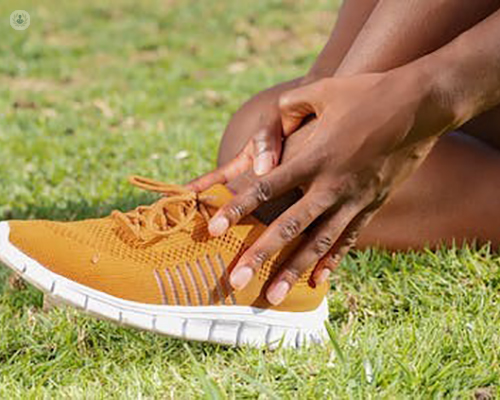Ankle sprains unveiled: A comprehensive guide
Written by:In his latest online article, Mr Barry Rose gives us his insights into sprained ankle. He talks about what it is, most common causes, how long an athlete should refrain from sporting activity, the recovery and rehabilitation for athletes and if an athlete needs to do any long-term exercises.

What is an ankle sprain?
An ankle sprain involves harm to the ligaments encircling the ankle, which are the soft tissues that connect the bones around the ankle. This typically occurs following a simple twisting or rolling incident where no fractures or breaks occur, but rather, it's the ligaments themselves that sustain injury.
What are the most common causes of a sprained ankle?
We've all experienced ankle sprains at some point, which is quite common. It can range from minor to more severe injuries. Simple actions like rolling or twisting the ankle, landing awkwardly after a jump, or making sudden movements during activities like kicking a ball or playing tennis can lead to both simple and complex ankle sprains. These occurrences are very common.
How long should an athlete not engage in sporting activity if they have a sprained ankle?
The time it takes to recover from an ankle sprain largely depends on how severe it is. We've all experienced mild sprains were, after a few days, we're back to our regular activities, just like athletes. However, more serious injuries can resemble a broken ankle and may require up to six weeks to return to normal activities. The rehabilitation process is closely tied to the injury's severity, the symptoms experienced, and the individual's readiness to resume sports.
What is the recovery and rehabilitation protocol for a sprained ankle for athletes?
After any sudden injury, like an ankle sprain, it's essential to follow standard first aid steps. These steps involve the principles of rest, ice, compression, and elevation (RICE). We recommend that individuals rest the affected limb, avoid their usual activities, apply ice packs (even frozen peas can work) to reduce swelling, use an elastic bandage for compression, and elevate the leg. Once these initial first aid measures are done, patients can start a rehabilitation process, which varies based on the injury's severity. It may involve using ankle support or a brace, and in severe cases, even crutches initially. When patients are ready, we usually recommend physiotherapy and specific exercises to strengthen the ankle and return to regular activities.
Are there any long-term exercises after a sports ankle sprain that athletes will need to do?
The reassuring news for most people who've had an ankle sprain is that they can expect to return to their regular activities about 90% of the time, and sometimes even more often than that.
However, there are exercises that can be quite beneficial in maintaining or improving the strength around the ankle, reducing the risk of future sprains, and enhancing overall control. In the early stages of recovery, this might involve simple measures like gently moving the ankle to improve its range of motion. Afterward, there are exercises called isometric exercises, which aim to strengthen the ankle. A physiotherapist can guide you through these exercises. As you progress, you may also incorporate more advanced exercises like single-leg squats and hops, as well as lateral movements. Sometimes, tools like a wobble board or a physiotherapy device such as a TheraBand may be used to provide resistance during rehabilitation exercises.
Initially, it's advisable to work with a physiotherapist, but many of these exercises can eventually be done independently, allowing you to do them at your own convenience.
Mr Barry Rose is a distinguished orthopaedic foot and ankle surgeon with over 15 years of experience. You can schedule an appointment with Mr Rose on his Top Doctors profile.


